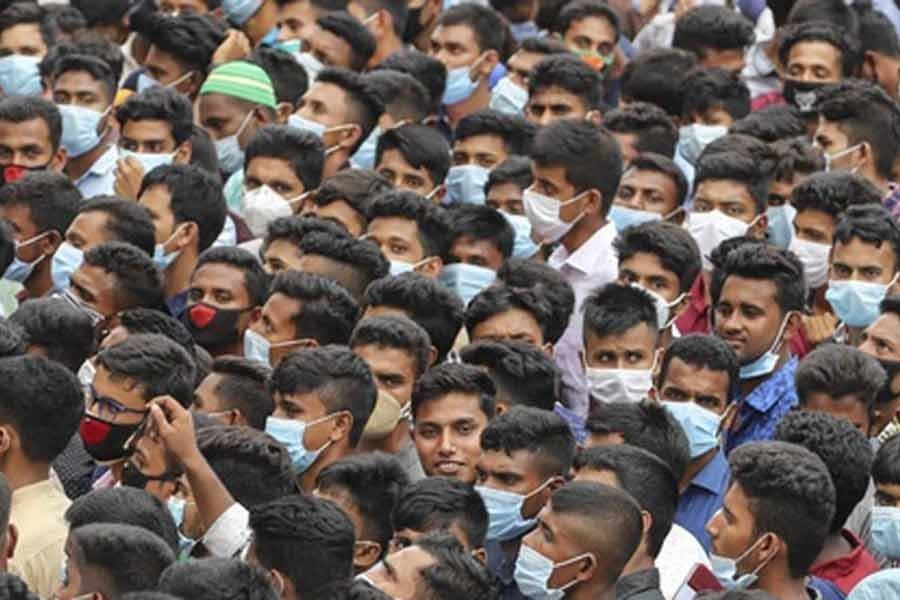
Published :
Updated :

It has been dubbed the country's first digital population census. Released on Wednesday last, the Population and Housing Census 2022 has come up with yet another 'first' in the country's demographic development. It is for the first time that females have outnumbered males. Although the difference is not big and unlikely to create a gender imbalance in society, the factors that have been responsible for tipping the balance in favour of women are subjects of serious study.
According to the latest census delayed by a year on account of the coronavirus pandemic, the country has a total population of 165,158,616 of which 81,712,824 are male and 83,347,206 are female. The number of transgender population is 12,629. What is particularly relishing is the decline in population growth from 1.86 per cent in 2011 to 1.22 per cent in 2022 in this overpopulated country. Yet an addition of more than 20 million to 144 million making the total 165 million within a gap of 11years does not quite give the nation enough cause to be at ease.
So far as the gender parity is concerned, much depends on the socio-psychological transformation in favour of leaving enough space for a girl child's growth ---both physical and mental. Mortality rates among girl children and mothers may have declined more than before and their reduced dependence on male members of families together have contributed to a grand total greater than that of the male. Also, female enrolment in educational institutions may have played a part by raising awareness among them about health, hygiene and sanitation.
A highly important parameter of demographic distribution is the equation between rural-urban inhabitants. According to the 2022 census, more than 113 million people live in villages while 52 million in cities and towns. A study carried out by the United Nations' Population Division in 2018 gave an ample indication that the shift towards urban living among the Bangladesh population will be particularly evident by 2030. Such developments have both positive and negative impacts but at a time of faster climate change, the adversity may outweigh gains.
Instead of encouraging rural-to-urban migration, the urgency is to concentrate on village-centric development with the bare minimum facilities for people leading a decent life. There ought to be enough resources and employment opportunities to support such a living standard. The yawning disparities between villages and urban centres have to be gradually reduced in order to bring about a social balance and economic justice.
On religious line, the picture that emerges is disturbing to all who are secular and believe in multilateralism. While the Muslim population has been increasing with an increase to 91.09 per cent from 90.39 per cent, the Hindus have witnessed a decline from 8.54 per cent to 7.95 per cent, so have the Buddhists from 0.62 to 0.61 per cent, the Christian from 0.31 to 0.30 per cent. Following the same trend, populations of other faiths have also an average decline from 0.14 per cent to 0.12 per cent.
Pulls and counter-pulls can act as balancing factors in society but overwhelming unilateralism can at times obstruct developments by giving rise to unnecessary tensions and frictions. The 35 pieces of personal and household information gathered from citizens may have more or less given a comprehensive picture of the status of a family and by extension the state of the republic.
Literacy has happily increased by 22.89 per cent to 74.66 per cent in 2022 from 51.77 per cent in 2011 but what about functional literacy and more importantly quality of education that pulls the country ahead by enhanced knowledge and skills as well as innovation for wealth creation. A census like this is unlikely to capture the real picture of human resources unless the questionnaire is prepared by development practitioners. Equally true is the inability to tap the cultural parameters. Unless people are culturally enlightened, all other achievements get stunted.
So, one uneasy question that is still likely to agitate many a mind concerns the information gatherers' seriousness in getting out the authentic information from people. There is a tendency among data collectors to manufacture information on some sample responses. Any such perfunctory exercise cannot be ruled out unless the data collectors are quite aware of the importance of the authenticity of demographic information.
Clearly, it is unlikely to qualify as a digital database of the nation. But there were ample opportunities for preparing one such data pool of the nation. Even if it turns out to be a comprehensive digital population census, it cannot serve as a national database in the true sense of the term. Such a database can be highly useful for planning with the population resources in a scientific manner.
Preparation of such a database surely would have involved some additional costs but the returns on those would have been many times more. One example is the shrinking of remittance earned by an increasing number of migrant workers. The other instance can be educated youth's successful involvement with entrepreneurial ventures. This is where making the population more resourceful than before matters. A digital database could help immensely in the task of expediting the process of nation building.


 For all latest news, follow The Financial Express Google News channel.
For all latest news, follow The Financial Express Google News channel.